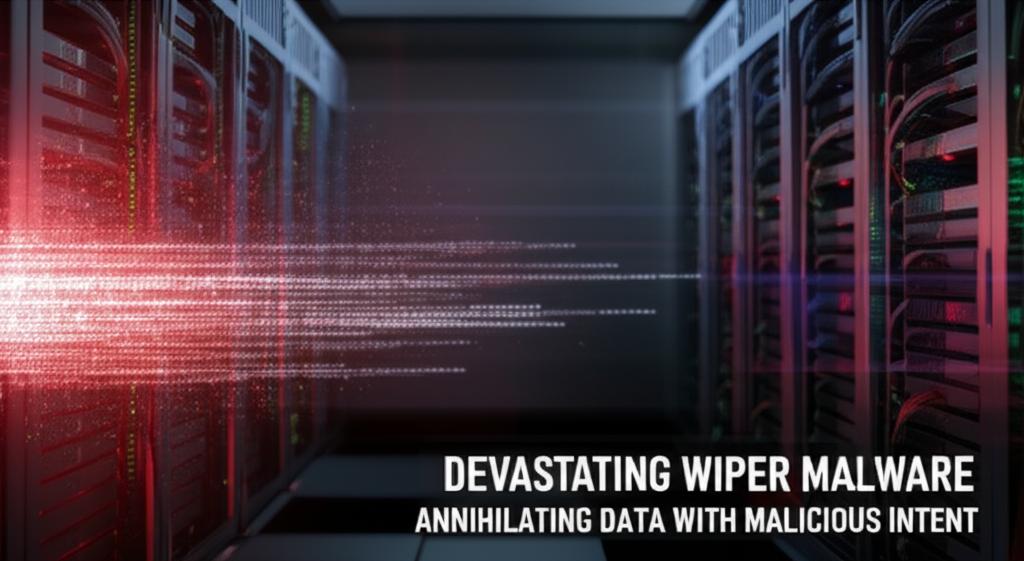Devastating Wiper Malware: Annihilating Data with Malicious Intent
Understanding Wiper Malware: The Ultimate Data Destroyer
In the evolving landscape of cyber threats, wiper malware stands out as a particularly destructive category. Unlike ransomware, which encrypts data with the promise of restoration upon payment, wiper malware has a singular, malicious goal: to permanently delete or corrupt data, rendering systems unrecoverable. This makes it one of the most feared and devastating tools in an attacker’s arsenal, often used in acts of cyber warfare, corporate espionage, or pure vandalism.
What Exactly is Wiper Malware?
Wiper malware is a type of malicious software designed to erase or overwrite data on a computer or network. Its primary function is to destroy information on the infected system, making it inaccessible and often impossible to restore. This can range from overwriting files and boot sectors to completely formatting hard drives, effectively ‘wiping’ the system clean of its valuable data.
How Wiper Malware Works
The operational mechanisms of wiper malware can vary, but generally, they follow a similar destructive path:
- Initial Infection: Like many other forms of malware, wiper attacks often begin with phishing emails, exploiting unpatched vulnerabilities, or through compromised software updates.
- System Access and Privilege Escalation: Once inside, the malware attempts to gain elevated privileges to access critical system files and storage devices.
- Data Overwriting/Corruption: The core of the wiper’s action involves systematically overwriting files with junk data (zeros or random characters) or manipulating the file system’s metadata to make data unreadable. Some advanced wipers target specific file types or entire partitions.
- Master Boot Record (MBR) Destruction: Many wiper variants specifically target the MBR, which contains information about how the logical partitions on a hard disk are organized and where the operating system is located. Destroying the MBR prevents the system from booting up, effectively bricking the device.
- Evading Detection: Sophisticated wipers might employ techniques to remain stealthy during their initial phase, only activating their destructive payload after a certain condition is met or at a specific time, making prevention and early detection challenging.
Notable Wiper Malware Incidents
Several high-profile incidents have brought the destructive power of wiper malware into sharp focus:
- Shamoon (2012, 2016-2017): One of the earliest and most infamous wiper attacks, Shamoon targeted Saudi Arabian oil company Saudi Aramco, destroying data on tens of thousands of computers.
- Sony Pictures Entertainment Attack (2014): The “Guardians of Peace” group used a wiper to devastate Sony’s corporate network, destroying critical data and leaking sensitive information.
- NotPetya (2017): Initially disguised as ransomware, NotPetya quickly revealed its true nature as a wiper, causing billions of dollars in damage globally, particularly affecting organizations in Ukraine and those doing business with them. It exploited the EternalBlue vulnerability.
- HermeticWiper and IsaacWiper (2022): These wipers were deployed against Ukrainian targets amidst geopolitical tensions, illustrating their use in cyber warfare to disable critical infrastructure and government systems.
Why Wiper Malware is So Dangerous
The danger of wiper malware lies in its irrevocability. Unlike ransomware, where there’s a theoretical chance of data recovery (even if paying the ransom is not recommended), a successful wiper attack means permanent data loss. This can lead to:
- Irreversible Data Loss: Critical business documents, customer data, intellectual property, and operational files can be wiped forever.
- Operational Downtime: Organizations can suffer prolonged periods of operational paralysis, leading to significant financial losses.
- Reputational Damage: Loss of trust from customers and partners due to data destruction and service unavailability.
- High Recovery Costs: Rebuilding systems from scratch, investing in new hardware, and restoring data from backups (if available and not also compromised) can be extremely expensive and time-consuming.
Strategies to Protect Against Wiper Malware
While no defense is foolproof, a multi-layered security strategy can significantly reduce the risk and impact of a wiper malware attack:
- Robust Backup and Recovery Plan: Implement a 3-2-1 backup strategy (three copies of data, on two different media, one offsite/offline). Regularly test your backups to ensure they are recoverable and isolated from your main network.
- Patch Management: Keep all operating systems, applications, and network devices updated with the latest security patches to close known vulnerabilities.
- Endpoint Detection and Response (EDR): Deploy advanced EDR solutions that can detect and respond to unusual activities indicative of malware, even new or unknown variants.
- Network Segmentation: Isolate critical systems and data from the rest of the network to contain potential breaches and limit the lateral movement of malware.
- Strong Authentication: Implement multi-factor authentication (MFA) for all accounts, especially for administrative access.
- Employee Training: Educate employees about phishing, social engineering, and safe computing practices to prevent initial infection vectors.
- Incident Response Plan: Develop and regularly practice an incident response plan to quickly detect, contain, and recover from a wiper attack.
Understanding and preparing for the destructive potential of wiper malware is crucial for any organization aiming to protect its digital assets in today’s threat landscape. Proactive defense and a robust recovery strategy are your best lines of defense against these devastating attacks.







